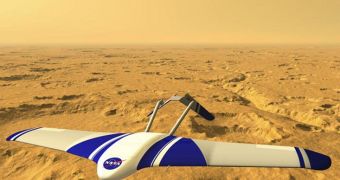Given the large number of signs pointing to the existence of life on the Red Planet, it stands to reason that exploring it even further is the way to go. Experts believe that future studies will be carried out from airplanes.
Thus far, Mars has been investigated using landers, rovers and orbiters, and all of these instruments have brought their priceless contribution to the growing database of Martian information we now have.
But the tantalizing evidences of past liquid water on the face of the planet merit a closer inspection, from inside the atmosphere, and above ground levels. This is where Martian airplanes come in.
Experts at the NASA Langley Research Center, in Hampton, Virginia, have been developing the ARES rocket-powered robotic airplane for Mars, under the guidance of atmospheric scientist Joel Levine.
The expert believes that such a platform would do a wonderful job at exploring the Red Planet, and also in shedding some light on some of its many mysteries, Space reports.
According to the expert, the main goal of such a prospective mission would be to collect visual images and remote sensing data of huge swaths of land, perhaps covering hundreds of miles in length.
Flights could be carried out at an altitude of about 1.6 kilometers, or 1 mile, and could cover swaths of land similar to those imaged by the HiRISE instrument on the Mars Reconnaissance Orbiter (MRO).
“A powered airplane flying a mile above the surface can obtain measurements over inaccessible parts of Mars and collect a whole bunch of data that no rover can collect,” Levine argues.
An added advantage would be that the close proximity to the ground would still allow the airplanes ot collect chemical sensing data, as well as very detailed images. Orbiters cannot do this.
The Aerial Regional-Scale Environmental Surveyor (ARES)will be proposed during the next NASA Mars mission solicitation. A team of 250 experts is working on developing the airplane, and a model has already been built.
“There are some very interesting things in the southern hemisphere. There are regions of very high crustal magnetism, whose origin no one understands,” Levine says of the possible applications for ARES.
“By studying crustal magnetism, we can learn whether it will shield the surface of Mars from high-energy solar wind particles. This will help us learn more about radiation that humans on the surface will experience,” he adds.
Scientists working on ARES already know what to do when the next NASA decision comes. Their mission has already been proposed in 2002, but the Phoenix Mars Lander was chosen instead.

 14 DAY TRIAL //
14 DAY TRIAL //